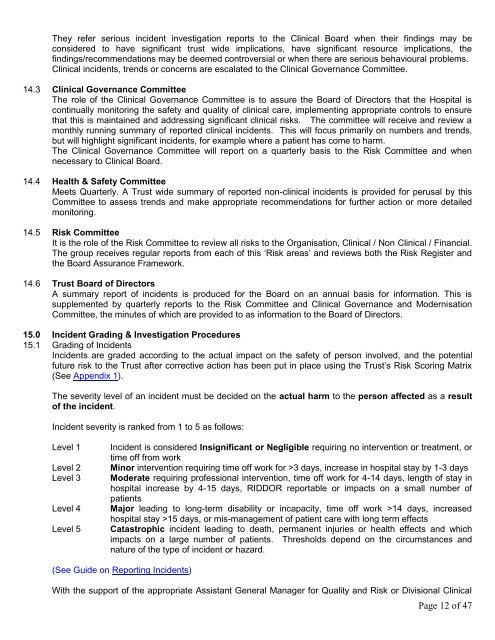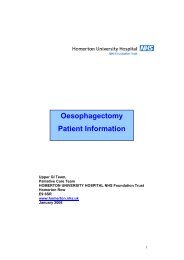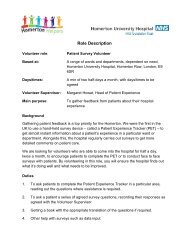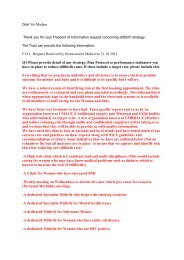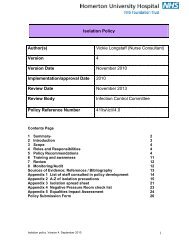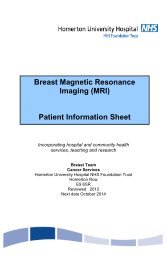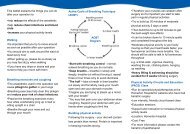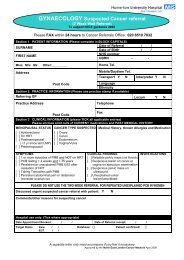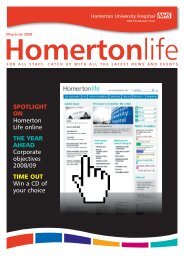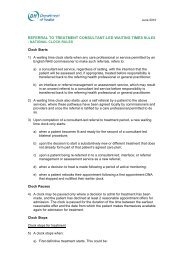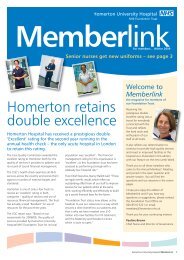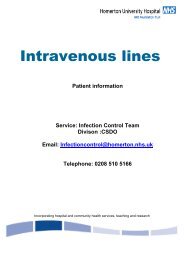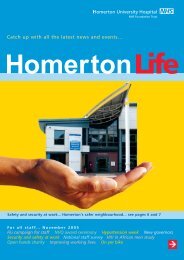Incident reporting policy - Homerton University Hospital
Incident reporting policy - Homerton University Hospital
Incident reporting policy - Homerton University Hospital
You also want an ePaper? Increase the reach of your titles
YUMPU automatically turns print PDFs into web optimized ePapers that Google loves.
They refer serious incident investigation reports to the Clinical Board when their findings may beconsidered to have significant trust wide implications, have significant resource implications, thefindings/recommendations may be deemed controversial or when there are serious behavioural problems.Clinical incidents, trends or concerns are escalated to the Clinical Governance Committee.14.3 Clinical Governance CommitteeThe role of the Clinical Governance Committee is to assure the Board of Directors that the <strong>Hospital</strong> iscontinually monitoring the safety and quality of clinical care, implementing appropriate controls to ensurethat this is maintained and addressing significant clinical risks. The committee will receive and review amonthly running summary of reported clinical incidents. This will focus primarily on numbers and trends,but will highlight significant incidents, for example where a patient has come to harm.The Clinical Governance Committee will report on a quarterly basis to the Risk Committee and whennecessary to Clinical Board.14.4 Health & Safety CommitteeMeets Quarterly. A Trust wide summary of reported non-clinical incidents is provided for perusal by thisCommittee to assess trends and make appropriate recommendations for further action or more detailedmonitoring.14.5 Risk CommitteeIt is the role of the Risk Committee to review all risks to the Organisation, Clinical / Non Clinical / Financial.The group receives regular reports from each of this „Risk areas‟ and reviews both the Risk Register andthe Board Assurance Framework.14.6 Trust Board of DirectorsA summary report of incidents is produced for the Board on an annual basis for information. This issupplemented by quarterly reports to the Risk Committee and Clinical Governance and ModernisationCommittee, the minutes of which are provided to as information to the Board of Directors.15.0 <strong>Incident</strong> Grading & Investigation Procedures15.1 Grading of <strong>Incident</strong>s<strong>Incident</strong>s are graded according to the actual impact on the safety of person involved, and the potentialfuture risk to the Trust after corrective action has been put in place using the Trust‟s Risk Scoring Matrix(See Appendix 1).The severity level of an incident must be decided on the actual harm to the person affected as a resultof the incident.<strong>Incident</strong> severity is ranked from 1 to 5 as follows:Level 1Level 2Level 3Level 4Level 5<strong>Incident</strong> is considered Insignificant or Negligible requiring no intervention or treatment, ortime off from workMinor intervention requiring time off work for >3 days, increase in hospital stay by 1-3 daysModerate requiring professional intervention, time off work for 4-14 days, length of stay inhospital increase by 4-15 days, RIDDOR reportable or impacts on a small number ofpatientsMajor leading to long-term disability or incapacity, time off work >14 days, increasedhospital stay >15 days, or mis-management of patient care with long term effectsCatastrophic incident leading to death, permanent injuries or health effects and whichimpacts on a large number of patients. Thresholds depend on the circumstances andnature of the type of incident or hazard.(See Guide on Reporting <strong>Incident</strong>s)With the support of the appropriate Assistant General Manager for Quality and Risk or Divisional ClinicalPage 12 of 47


